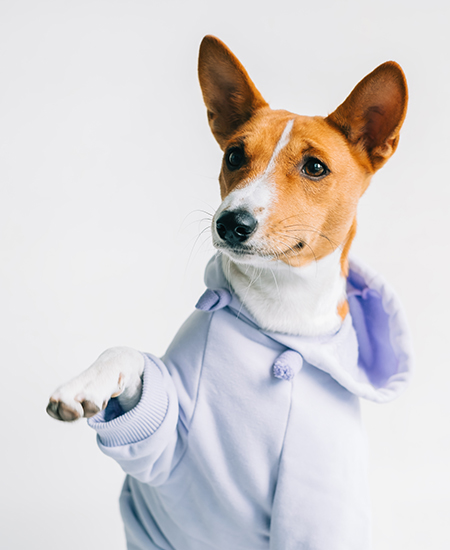As our beloved dogs grow older, their needs change dramatically. Just like senior humans, older dogs often face challenges such as joint pain, arthritis, decreased mobility, and sensitivity to cold. Providing extra comfort and care for senior dogs is essential to ensure they enjoy their golden years with happiness and ease. One practical and effective way to support your aging pet is through dog clothes designed specifically for senior dogs. Alongside regular dog grooming, clothing can help keep older pets cozy, reduce discomfort, and improve their overall quality of life.
In this blog, we’ll explore why clothing is important for senior dogs, how to choose the right garments, and tips to make dressing your furry friend a positive experience
Why Senior Dogs Benefit from Clothing
As dogs age, their metabolism slows down, and they become more susceptible to temperature changes. Older dogs can struggle to regulate their body heat due to thinning fur, weight loss, or medical conditions. This can make cold weather especially harsh, leading to stiffness, joint pain, and general discomfort.
The Impact of Cold on Senior Dogs
Cold weather can exacerbate arthritis and other musculoskeletal problems common in senior dogs. Chilly muscles and joints tend to become stiff and painful, making movement difficult. A warm, snug garment can help maintain body temperature, soothe achy joints, and reduce the stress of cold weather.
Protection for Sensitive Skin and Fur
Senior dogs sometimes develop sensitive skin or lose fur due to health issues. Clothing provides a protective barrier against environmental irritants, allergens, and harsh weather conditions like wind, rain, or snow. It can also prevent excessive licking or scratching of vulnerable areas.
Encouraging Mobility and Confidence
Wearing soft, comfortable clothing may encourage older dogs to move more freely by keeping their muscles warm and supported. This can lead to increased confidence during walks and playtime, improving their mental well-being.
Choosing the Right Dog Clothes for Senior Pets
When selecting dog clothes for senior dogs, comfort and function should be your top priorities. Here’s what to consider:
1. Fabric and Material
Choose soft, breathable fabrics that provide warmth without causing overheating. Cotton blends, fleece, and lightweight wool are excellent options. Avoid materials that may irritate sensitive skin, such as rough synthetics or fabrics with itchy seams.
2. Easy to Put On and Take Off
Senior dogs may have limited mobility or be easily stressed by clothing changes. Look for garments with simple closures like Velcro or snap buttons instead of complicated zippers or tight elastic bands. This makes dressing hassle-free for both you and your dog.
3. Proper Fit
Clothing that is too tight can restrict movement or cause discomfort, while overly loose garments may get tangled or caught. Measure your dog carefully around the chest, neck, and length before purchasing. A good fit ensures warmth and freedom to move naturally.
4. Special Features for Senior Dogs
Some dog clothes come with orthopedic benefits, such as built-in support or compression panels. These can help reduce joint swelling and improve circulation. Additionally, consider coats with reflective strips if your dog enjoys evening walks.
5. Weather Appropriateness
Different seasons require different types of clothing. In winter, insulated coats or sweaters provide necessary warmth, while in milder seasons, lighter shirts can protect against sunburn or bugs without overheating.
Popular Types of Clothing for Senior Dogs
Here are some common clothing types that benefit older dogs:
Sweaters and Hoodies
Sweaters made of soft knit or fleece are ideal for indoors and mild outdoor conditions. They keep your senior dog warm without adding bulk and can be worn during gentle play or rest.
Insulated Jackets
For colder climates, insulated jackets with water-resistant shells protect dogs from snow and rain while providing warmth. These are great for senior dogs who still enjoy outdoor walks but need extra protection.
Orthopedic Compression Shirts
Compression shirts apply gentle pressure to the torso, supporting muscles and joints. These are particularly helpful for dogs with arthritis or recovering from injury, promoting better blood flow and reducing inflammation.
Pajamas or Onesies
For dogs with sensitive skin or those prone to scratching, pajamas or onesies can cover problem areas, preventing further irritation. They are also cozy options for chilly nights.
Incorporating Dog Clothes into Daily Routine
To help your senior dog adjust to wearing clothes, make the experience as positive and stress-free as possible.
Start Slowly
Introduce clothing gradually. Let your dog sniff and inspect the garment before trying it on. Put the clothes on for short periods initially, increasing wear time as your dog becomes more comfortable.
Use Treats and Praise
Reward your dog with treats and affection when they wear clothes. This positive reinforcement builds a good association with the experience.
Monitor Comfort and Behavior
Keep an eye on your dog’s behavior while dressed. Signs of discomfort such as excessive scratching, biting at the garment, or reluctance to move indicate the clothes may not fit properly or might be irritating.
Keep Up with Regular Dog Grooming
Regular dog grooming routines complement the benefits of clothing. Clean fur and skin ensure better comfort under garments and prevent matting or infections that could be worsened by clothing.
Dog Grooming Tips for Senior Dogs
As dogs age, their grooming needs change. Older dogs may have decreased mobility, making it harder for them to groom themselves properly. Proper grooming supports skin health and makes wearing dog clothes more comfortable.
Brushing and Coat Care
Gently brush your senior dog’s coat regularly to remove loose fur, dirt, and prevent tangles. Use soft-bristle brushes suitable for their coat type. This helps maintain insulation and comfort beneath clothing.
Bathing Considerations
Bath your senior dog only as needed, using mild shampoos formulated for sensitive or aging skin. Overbathing can dry out the skin, making it more prone to irritation.
Nail Trimming and Paw Care
Older dogs may have thicker, brittle nails. Keep nails trimmed to prevent discomfort during walks or when wearing boots or socks. Check paws for cracks or dryness, and apply moisturizing balms if needed.
Ear and Dental Care
Maintain regular ear cleaning to prevent infections and dental hygiene to avoid oral health issues that can affect overall well-being.
Addressing Mobility Issues Alongside Clothing
While dog clothes provide warmth and comfort, mobility challenges often require additional care:
Supportive Harnesses and Slings
For dogs with difficulty walking or climbing stairs, harnesses or slings can offer support. These work well in combination with clothing to keep your senior dog comfortable and secure.
Orthopedic Beds and Mats
Provide a cozy resting place with orthopedic beds that relieve pressure on joints. Clothing can keep your dog warm while they rest, preventing stiffness.
Gentle Exercise and Massage
Regular, low-impact exercise and gentle massage help maintain joint flexibility and muscle tone, improving your senior dog’s comfort while wearing clothing.
When Not to Use Dog Clothes
While clothing offers many benefits, there are situations where it may not be appropriate:
- Dogs prone to overheating, especially in warm climates
- Dogs with skin infections or open wounds where clothing could trap moisture and worsen the issue
- Dogs who show extreme distress or aggression when dressed
In such cases, consult your veterinarian for alternative ways to keep your senior dog comfortable.
Final Thoughts
Providing dog clothes for senior dogs is a wonderful way to keep your older pets cozy, protected, and pain-free. When paired with regular dog grooming, clothing becomes part of a comprehensive care routine that supports your dog’s health and happiness in their later years. Prioritizing comfort, proper fit, and gradual introduction can help your senior dog enjoy the benefits of clothing without stress.
As you care for your aging canine companion, remember that warmth and protection are just part of the picture—love, patience, and attentive care will always be the most important ingredients in keeping your senior dog joyful and comfortable throughout their golden years.



